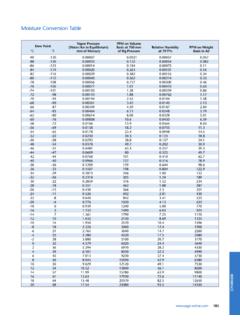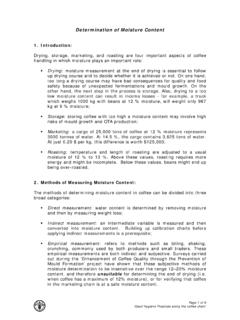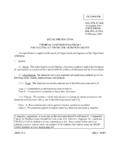Transcription of Fuel and Energy Conversion and Equivalence Chart
1 1 Fuel and Energy Conversion and Equivalence Chart Please note, the fuel economy estimates within this document are examples only. Maine Public Service does not consult with customers regarding fuel source selection. For accurate pricing, fuel source recommendations, and additional information, please contact your Energy supplier. Comparing Heating Fuels Selecting the fuel and heating system best suited for your needs depends on many factors. These include: the cost and availability of the fuel or Energy source; the type of appliance used to convert that fuel to heat and how the heat is distributed in your house; the cost to purchase, install, and maintain the heating appliance; the heating appliance s and heat delivery system s efficiency; and the environmental impacts associated with the heating fuel.
2 One somewhat simple way to evaluate heating options is to compare the cost of the fuel. To do that, you have to know the Energy content of the fuel and the efficiency by which it is converted to useful heat. Fuels are measured in physical units, such as gallons of oil or propane, cubic feet of natural gas, or kilowatt hours or electricity (kWh). They are also measured by heat content. In the United States, the most commonly used value for expressing the Energy value or heat content of a fuel is the British thermal unit (Btu). One Btu is the amount of Energy needed to raise the temperature of one pound of water one degree Fahrenheit (F), when water is at about 39 degrees F.
3 One therm is 100,000 Btu. Btu Content of Fuels Since the actual heat content of different types of fuels varies, the approximate average values are often used. The table below provides a list of typical heating fuels and the Btu content in the units that they are typically sold in the United States. The figures below are general references for residential heating applications only. Commercial and industrial users should obtain more precise values from their fuel vendors. 1 2 Table 1 Average Btu Content of Fuels Electricity: 1 KW 3,412 Btu/hr Natural Gas: 1 Cubic Foot of Natural Gas 1,030 Btu s 1 CCF = 100 Cu Ft = 1 Therm 103,000 Btu s 1 MCF = 1,000 Cu Ft = 10 Therms 1,034,000 Btu s = MMBtu s Propane: 1 Gal Propane 91,600 Btu s 1 Cu Ft Propane 2,500 Btu s Gasoline: 1 Gal of Gasoline (mid grade) 125,000 Btu s Ethanol: 1 Gal of Ethanol 76,000 Btu s Fuel Oil: 1 Gal of #1 Kerosene 135,000 Btu s 1 Gal of #2 Fuel Oil 138,000 Btu s 1 Gal of #4 Fuel Oil 145,000 Btu s 1 Gal of #6 Fuel Oil 150,000 Btu s Other.
4 Wood (air dried) 20,000,000/cord or 8,000/pound Pellets (for pellet stoves; premium) 16,500,000/ton Coal 28,000,000/ton 1 Barrel of Oil = 42 Gallons 1 Btu = 252 calories 1 Btu = .293 watt 1 ton of refrigeration = 12,000 Btu/hr 1lb residential garbage = 2,500 Btu 1lb coal = 12,000 Btu 1lb wood = 3,500 Btu 1hp = 746 watts 1hp = 33,479 Btu/hr (boiler) 1hp = 33,000 1hp = 42,440 Btu/min. 1 watt = Btu 1 kilowatt = 1,000 watts 1 kilowatt = horsepower 1,000 kilowatts = 1 Megawatt 3 All of the following fuels are equivalent to 1,000,000 Btu s.
5 Electricity kWh (3,412 Btu/kWh) Natural Gas: 1 MCF, 10 therms or 1,000 cubic feet Coal: pounds @ 12,000 Btu/pound Propane gallons @ 91,000 Btu/gallon Gasoline gallons @125,000 Btu/gallon Fuel Oil #2 gallons @ 139,000 Btu/gallon Fuel Oil #6 gallons @ 150,000 Btu/gallon Wood pounds @ 3.
6 500 Btu/pound 2 These standards of measurement make comparisons of fuel types possible. For example: The heat content of one gallon of fuel oil roughly equals that of 41 kWh of electricity, 137 cubic feet of natural gas, gallons of propane, pounds of air-dried wood, 17 pounds of pellets, a gallon of kerosene, or 10 pounds of coal. One million Btu s is the heat equivalent of approximately 7 gallons of No. 2 heating oil or kerosene, 293 kWh of electricity, 976 cubic feet of natural gas, 11 gallons of propane, 125 pounds of air-dried wood, 121 pounds of pellets, or 71 pounds of coal.
7 The efficiency of the heating appliance is an important factor when determining the cost of a given amount of heat. In general, the efficiency is determined by measuring how well an appliance turns fuel into useful heat. (The condition of the heat distribution or delivery system also affects the overall system efficiency.) Many types of space heating appliances must meet minimum standards for efficiency developed by the Department of Energy . Table 2 provides average efficiencies for common heating appliances. 4 Table 2: Estimated Average Fuel Conversion Efficiency of Common Heating Appliances Fuel Type - Heating Equipment Efficiency (%) Coal (bituminous) Central heating, hand-fired Central heating, stoker-fired Water heating, pot stove (50 gal.)
8 Oil High efficiency central heating Typical central heating Water heater (50 gal.) Gas Propane High efficiency central furnace Typical central boiler Minimum efficiency central furnace Room heater, unvented Room heater, vented Water heater (50 gal.) Electricity Baseboard, resistance Central heating, forced air Central heating, heat pump 200+ Ground source heat pump 300+ Water heaters (50 gal.) Wood and Pellets Stoves with circulating fans - Catalytic stoves - Pellet stoves - Wood heating values can vary significantly. The most important factor affecting useful Btu content is the moisture content of the wood.
9 Well-seasoned, air-dried wood will typically have a moisture content of around 20 percent (when compared to a bone dry sample of the wood). A very rough approximation of the effect of moisture content on the heating value is for every percent increase in moisture content (relative to a bone-dry sample) there is a one percent decrease in heating value. The other factor affecting heat content is the tree species of the wood. Higher heating values of wood can vary from 8,000 to 10,000 Btu per pound, bone dry. A cord of wood is a rough measuring unit; it is a stack of wood 4 feet high, 8 feet long, and 4 feet wide.
10 A good cord of wood will be tightly packed. Pellet fuels are usually made from sawdust. The Btu content will therefore vary depending on the type of wood that the sawdust is from. Pellet fuels typically have a moisture content of around 10 percent. 5 Most of the appliance efficiencies given in Table 2 above roughly account for the net heating value fuels used in a vented appliance ( one that has a chimney). An unvented space heater, such as a kerosene heater or a natural gas fireplace insert, delivers nearly all of the heating value of a fuel to the space in which it is located.








